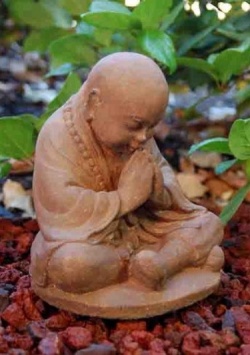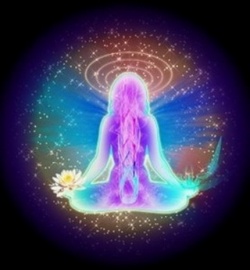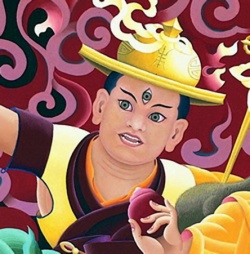Difference between revisions of "Buddhism and Vedanta"
(Created page with "{{DisplayImages|1111|1547|1035}} {{Centre|<big><big>Satsanga with Sri Swami Viditatmananda Saraswati<br/> Arsha Vidya Gurukulam<br/> Buddhism and Vedanta</big></big><br/>}}<br...") |
|||
| Line 9: | Line 9: | ||
Answer | Answer | ||
| − | The [[Indian]] {{Wiki|culture}} is a {{Wiki|Vedic}} {{Wiki|culture}}. [[Buddhism]] arose as a sort of protest to the {{Wiki|Vedic}} {{Wiki|culture}} of that [[time]]. Therefore, [[Buddhism]] doesn’t accept the [[Vedas]] as a [[pramāṇam]] or valid [[source of knowledge]]; it dismisses all the {{Wiki|Vedic}} [[rituals]]. Yet [[Buddhism]] is also an offspring of the [[Vedas]] and so the [[teaching]] of [[Buddhism]] is not too far removed from that of the [[Upanishads]]. It became a separate [[tradition]] and many were inspired to embrace [[Buddhism]]. [[Lord Buddha]] was a great and inspiring leader and [[teacher]] | + | The [[Indian]] {{Wiki|culture}} is a {{Wiki|Vedic}} {{Wiki|culture}}. [[Buddhism]] arose as a sort of protest to the {{Wiki|Vedic}} {{Wiki|culture}} of that [[time]]. Therefore, [[Buddhism]] doesn’t accept the [[Vedas]] as a [[pramāṇam]] or valid [[source of knowledge]]; it dismisses all the {{Wiki|Vedic}} [[rituals]]. Yet [[Buddhism]] is also an offspring of the [[Vedas]] and so the [[teaching]] of [[Buddhism]] is not too far removed from that of the [[Upanishads]]. It became a separate [[tradition]] and many were inspired to embrace [[Buddhism]]. [[Lord Buddha]] was a great and inspiring leader and [[teacher]]. |
| − | Even before Śrī Saṅkarācārya’s [[time]], a lot of work in the re-establishment of {{Wiki|Vedic}} {{Wiki|culture}} had been done. There was [[Kumārila]] | + | It said that at that [[time]], the {{Wiki|Vedic}} {{Wiki|culture}} had degenerated into too many [[rituals]] and sacrificial [[offerings]] of [[animals]] with a lot of {{Wiki|violence}}. [[Buddhism]] came up as a protest {{Wiki|reaction}} to that. Therefore, [[Gautama]] [[Buddha’s]] message of [[compassion]] appealed to the [[people]] and the new [[religion]] was accepted. Later, however, [[Buddhism]] also [[suffered]] [[decay]]. |
| + | |||
| + | Over [[time]], it became very [[intellectual]] and involved a lot of {{Wiki|argumentation}}, which resulted in divisions within it. [[Buddhism]] was in a bad [[state]] because it was purely [[intellectual]] and [[dialectical]]. A better [[form]] of {{Wiki|reasoning}} became necessary to show up the fallacies of the prevalent {{Wiki|Vedic}} {{Wiki|culture}}. That was when [[Ādi Saṅkarācārya]] came along. | ||
| + | |||
| + | |||
| + | Even before [[Śrī Saṅkarācārya’s]] [[time]], a lot of work in the re-establishment of {{Wiki|Vedic}} {{Wiki|culture}} had been done. There was [[Kumārila Bhatta]], a great ritualist, who also played a significant role in re-establishing the {{Wiki|Vedic}} {{Wiki|culture}}. [[Śrī Saṅkarācārya]] established the {{Wiki|tenets}} of the [[Upanishadic]] [[teaching]]. This was because the [[people]] of [[India]] basically followed {{Wiki|Vedic}} [[precepts]] and that was a way it could be brought back. [[Śrī Saṅkarācārya]] brought about a lot of reforms in the practice of [[rituals]] as well. Had that not happened, the {{Wiki|Vedic}} [[religion]] itself could have been wiped out. | ||
| + | |||
| + | Unless great leaders come as reformers, even [[religions]] become degenerate. Unfortunately, [[Buddhism]] did not have the kind of leader who could subsequently reform it and make it {{Wiki|practical}} for others to follow or provide an [[idea]] or [[path]] for others to follow. What is practically useful to [[people]] alone will survive and that is why {{Wiki|Vedic}} [[religion]] has survived. | ||
Question | Question | ||
| Line 19: | Line 26: | ||
Answer: | Answer: | ||
| − | At the [[time]] [[Gautama Buddha]] appeared on this [[earth]], there was a lot of distortion in the interpretation of what the [[Vedas]] prescribe. There was also a lot of corruption along with the distortion. It seems that there was a predominance of [[animal sacrifice]] in the performance of {{Wiki|Vedic}} [[rituals]] and thus there was {{Wiki|violence}} associated with it. Both [[Gautama Buddha]] as well as | + | At the [[time]] [[Gautama Buddha]] appeared on this [[earth]], there was a lot of [[distortion]] in the interpretation of what the [[Vedas]] prescribe. There was also a lot of corruption along with the [[distortion]]. It seems that there was a predominance of [[animal sacrifice]] in the performance of {{Wiki|Vedic}} [[rituals]] and thus there was {{Wiki|violence}} associated with it. Both [[Gautama Buddha]] as well as [[Vardhamana Mahavira]] of the [[Jain]] [[religion]] appeared in the same region at about the same [[time]], and both advocated [[ahiàsā]]. |
| + | |||
| + | This was because of the prevalent {{Wiki|atmosphere}} of [[hiàsā]] or {{Wiki|violence}} as the {{Wiki|Vedic}} [[rituals]] were equated to {{Wiki|sacrifice}}. Therefore, rather than reforming the {{Wiki|Vedic}} [[rituals]], they did away with it. The {{Wiki|ideal}} way would have been to teach [[ahiàsā]] in the {{Wiki|light}} of the {{Wiki|Vedic}} [[teaching]]; to give the [[people]] the [[right understanding]] of the [[Vedas]] and remove all the corruption that had entered into that. | ||
| + | |||
| + | Then the {{Wiki|Vedic}} [[religion]] would have been sustained or reformed and there would not have been conflict in the [[minds]] of the [[people]]. But what happened was that the two new [[traditions]] began as a protest against the {{Wiki|violence}} that was associated with the {{Wiki|Vedic}} [[rituals]]. The [[principle]] of [[non-violence]] is very [[noble]]. Yet I personally wish that this [[non-violence]] had been [[taught]] in keeping with the {{Wiki|Vedic}} [[teaching]]. | ||
| + | |||
| + | Any [[tradition]] that is followed for a long [[time]] is prone to corruption and [[distortion]]. Therefore, we require [[spiritual]] leaders from [[time]] to [[time]] who can spot those [[corruptions]] or [[distortions]] and set them right. | ||
| + | |||
| + | |||
| + | [[Ādi Saṅkarācārya]] was also a great reformer. He was very [[traditional]], no [[doubt]], and we would also call him {{Wiki|orthodox}} because he was faithful to the basic [[traditions]] of the [[Vedas]] including the [[caste]] system, the varṇāśrama–dharma, and so on. At the same [[time]], however, he introduced a lot of reforms. Even at the [[time]] of [[Śrī Saṅkarācārya]], there were many [[distortions]] in the [[forms]] of {{Wiki|worship}}, such as in the {{Wiki|worship}} of the {{Wiki|female}} [[divinity]]. [[Tantra]] is a [[form]] of worshiping the [[mother goddess]]. [[Distortions]] had entered into this {{Wiki|worship}}, which had become associated with the five ma-kāras, such as [[madya]] or [[liquor]], māàsa or flesh, etc. Also, the ferocious [[form]] of the [[Devi]] was worshipped through [[animal sacrifice]]. | ||
| + | |||
| + | [[Śrī Saṅkarācārya]] corrected this [[tradition]] and instituted the {{Wiki|worship}} of the benign [[form]] of the [[Goddess]]. He installed what we call the [[Śrī-yantra]] in many places and changed the [[form]] of {{Wiki|worship}} from the ferocious [[form]] to the benign [[forms]]. There was also a sort of [[division]] amongst [[Hindus]] who worshipped different [[deities]] in believing that their [[god]] was {{Wiki|superior}} to the other’s [[god]]. Therefore, he instituted the [[pañcāyatana-pūjā]] or the {{Wiki|worship}} of five [[deities]]: [[Lord]] [[Śiva]], [[Devi]] or [[Śakti]], [[Lord]] [[Viṣṇu]], [[Lord]] Gaṇeśa and [[Lord]] [[Sūrya]]. | ||
| + | |||
| + | These were the five [[devatās]] predominantly worshipped at that [[time]]. He [[initiated]] a {{Wiki|worship}} of all the five [[devatās]] in which the [[representation]] of one’s iṣṭa-devatā or chosen [[deity]] could be in the center and the other four in the four corners. In doing this, one could still show reverence to the iṣṭa-devatā while being respectful of the other [[devatās]]. | ||
| + | |||
| − | + | Many such reforms were [[initiated]]. [[People]] fault some of what [[Śrī Saṅkarācārya]] did, but you have to evaluate his work in the {{Wiki|light}} of the [[conditions]] [[existing]] at that [[time]]. After all, there are certain things you cannot do, perhaps because [[people]] are not ready for those changes. Yet, a lot of changes were brought about. | |
| − | + | You see, we cannot expect him to have done what we would do in the 21st century. Even the {{Wiki|Manusmṛti}} is being criticized today. Yet we have to understand the [[time]] when [[Manu]] lived and wrote and all the factors constraining him. Similarly, even today, we have to take into account the strong [[feelings]] of [[people]] even though we may not necessarily agree with them. We know that [[people]] are not ready for a complete change and, therefore, accept some things that may not necessarily be {{Wiki|ideal}}. | |
| − | + | While it would have been {{Wiki|ideal}} had these {{Wiki|Vedic}} [[traditions]] been maintained and reformed, such powerful leaders as [[Gautama Buddha]] or [[Mahavira]] did {{Wiki|excellent}} work; no [[doubt]] about that. To answer the question, [[Lord Buddha]] did away with the [[Vedas]] because, at that [[time]], the {{Wiki|Vedic}} [[rituals]] were full of {{Wiki|violence}}. Therefore, the [[Buddhists]] did not accept the [[Vedas]] as a [[pramāṇam]] or [[Wikipedia:Authenticity|authentic]] [[source of knowledge]]. Both the [[Buddhist tradition]] and the [[Jain]] [[tradition]] had their [[own]] [[scriptures]], which they followed<ref>2005 Arsha [[Vidya]] Gurukulam Family Camp satsanga. Transcribed and edited by [[Jaya]] Kannan, Chaya Rajaram and Jayshree Ramakrishnan.</ref>. | |
{{reflist}} | {{reflist}} | ||
Latest revision as of 03:32, 30 January 2015
Satsanga with Sri Swami Viditatmananda Saraswati
Arsha Vidya Gurukulam
Buddhism and Vedanta
Question
What is the reason that Buddhism was born in India, but is more widely practiced outside India?
Answer
The Indian culture is a Vedic culture. Buddhism arose as a sort of protest to the Vedic culture of that time. Therefore, Buddhism doesn’t accept the Vedas as a pramāṇam or valid source of knowledge; it dismisses all the Vedic rituals. Yet Buddhism is also an offspring of the Vedas and so the teaching of Buddhism is not too far removed from that of the Upanishads. It became a separate tradition and many were inspired to embrace Buddhism. Lord Buddha was a great and inspiring leader and teacher.
It said that at that time, the Vedic culture had degenerated into too many rituals and sacrificial offerings of animals with a lot of violence. Buddhism came up as a protest reaction to that. Therefore, Gautama Buddha’s message of compassion appealed to the people and the new religion was accepted. Later, however, Buddhism also suffered decay.
Over time, it became very intellectual and involved a lot of argumentation, which resulted in divisions within it. Buddhism was in a bad state because it was purely intellectual and dialectical. A better form of reasoning became necessary to show up the fallacies of the prevalent Vedic culture. That was when Ādi Saṅkarācārya came along.
Even before Śrī Saṅkarācārya’s time, a lot of work in the re-establishment of Vedic culture had been done. There was Kumārila Bhatta, a great ritualist, who also played a significant role in re-establishing the Vedic culture. Śrī Saṅkarācārya established the tenets of the Upanishadic teaching. This was because the people of India basically followed Vedic precepts and that was a way it could be brought back. Śrī Saṅkarācārya brought about a lot of reforms in the practice of rituals as well. Had that not happened, the Vedic religion itself could have been wiped out.
Unless great leaders come as reformers, even religions become degenerate. Unfortunately, Buddhism did not have the kind of leader who could subsequently reform it and make it practical for others to follow or provide an idea or path for others to follow. What is practically useful to people alone will survive and that is why Vedic religion has survived.
Question
Why did Lord Buddha tell the people to ignore the teachings of the Vedas?
Answer:
At the time Gautama Buddha appeared on this earth, there was a lot of distortion in the interpretation of what the Vedas prescribe. There was also a lot of corruption along with the distortion. It seems that there was a predominance of animal sacrifice in the performance of Vedic rituals and thus there was violence associated with it. Both Gautama Buddha as well as Vardhamana Mahavira of the Jain religion appeared in the same region at about the same time, and both advocated ahiàsā.
This was because of the prevalent atmosphere of hiàsā or violence as the Vedic rituals were equated to sacrifice. Therefore, rather than reforming the Vedic rituals, they did away with it. The ideal way would have been to teach ahiàsā in the light of the Vedic teaching; to give the people the right understanding of the Vedas and remove all the corruption that had entered into that.
Then the Vedic religion would have been sustained or reformed and there would not have been conflict in the minds of the people. But what happened was that the two new traditions began as a protest against the violence that was associated with the Vedic rituals. The principle of non-violence is very noble. Yet I personally wish that this non-violence had been taught in keeping with the Vedic teaching.
Any tradition that is followed for a long time is prone to corruption and distortion. Therefore, we require spiritual leaders from time to time who can spot those corruptions or distortions and set them right.
Ādi Saṅkarācārya was also a great reformer. He was very traditional, no doubt, and we would also call him orthodox because he was faithful to the basic traditions of the Vedas including the caste system, the varṇāśrama–dharma, and so on. At the same time, however, he introduced a lot of reforms. Even at the time of Śrī Saṅkarācārya, there were many distortions in the forms of worship, such as in the worship of the female divinity. Tantra is a form of worshiping the mother goddess. Distortions had entered into this worship, which had become associated with the five ma-kāras, such as madya or liquor, māàsa or flesh, etc. Also, the ferocious form of the Devi was worshipped through animal sacrifice.
Śrī Saṅkarācārya corrected this tradition and instituted the worship of the benign form of the Goddess. He installed what we call the Śrī-yantra in many places and changed the form of worship from the ferocious form to the benign forms. There was also a sort of division amongst Hindus who worshipped different deities in believing that their god was superior to the other’s god. Therefore, he instituted the pañcāyatana-pūjā or the worship of five deities: Lord Śiva, Devi or Śakti, Lord Viṣṇu, Lord Gaṇeśa and Lord Sūrya.
These were the five devatās predominantly worshipped at that time. He initiated a worship of all the five devatās in which the representation of one’s iṣṭa-devatā or chosen deity could be in the center and the other four in the four corners. In doing this, one could still show reverence to the iṣṭa-devatā while being respectful of the other devatās.
Many such reforms were initiated. People fault some of what Śrī Saṅkarācārya did, but you have to evaluate his work in the light of the conditions existing at that time. After all, there are certain things you cannot do, perhaps because people are not ready for those changes. Yet, a lot of changes were brought about.
You see, we cannot expect him to have done what we would do in the 21st century. Even the Manusmṛti is being criticized today. Yet we have to understand the time when Manu lived and wrote and all the factors constraining him. Similarly, even today, we have to take into account the strong feelings of people even though we may not necessarily agree with them. We know that people are not ready for a complete change and, therefore, accept some things that may not necessarily be ideal.
While it would have been ideal had these Vedic traditions been maintained and reformed, such powerful leaders as Gautama Buddha or Mahavira did excellent work; no doubt about that. To answer the question, Lord Buddha did away with the Vedas because, at that time, the Vedic rituals were full of violence. Therefore, the Buddhists did not accept the Vedas as a pramāṇam or authentic source of knowledge. Both the Buddhist tradition and the Jain tradition had their own scriptures, which they followed[1].


